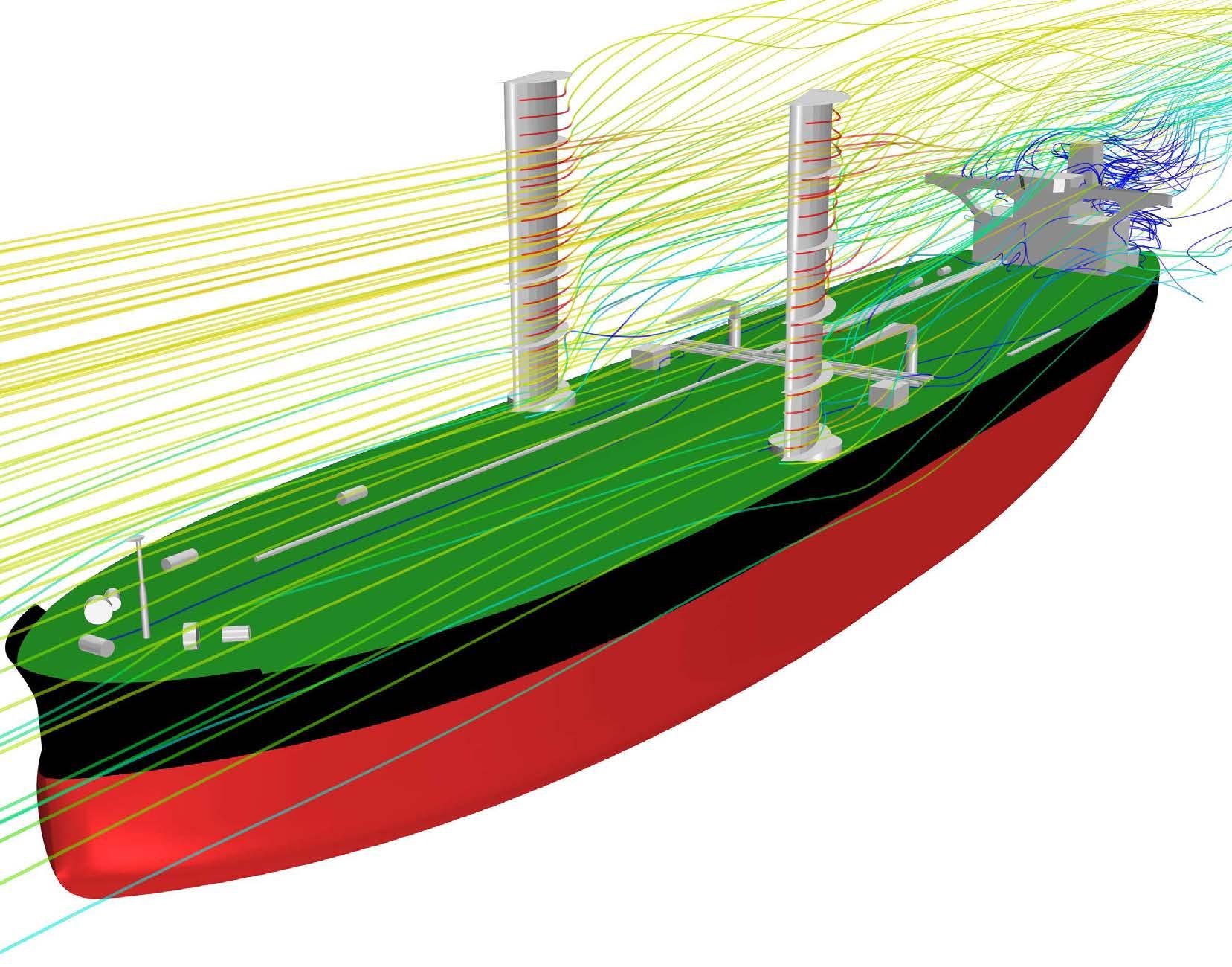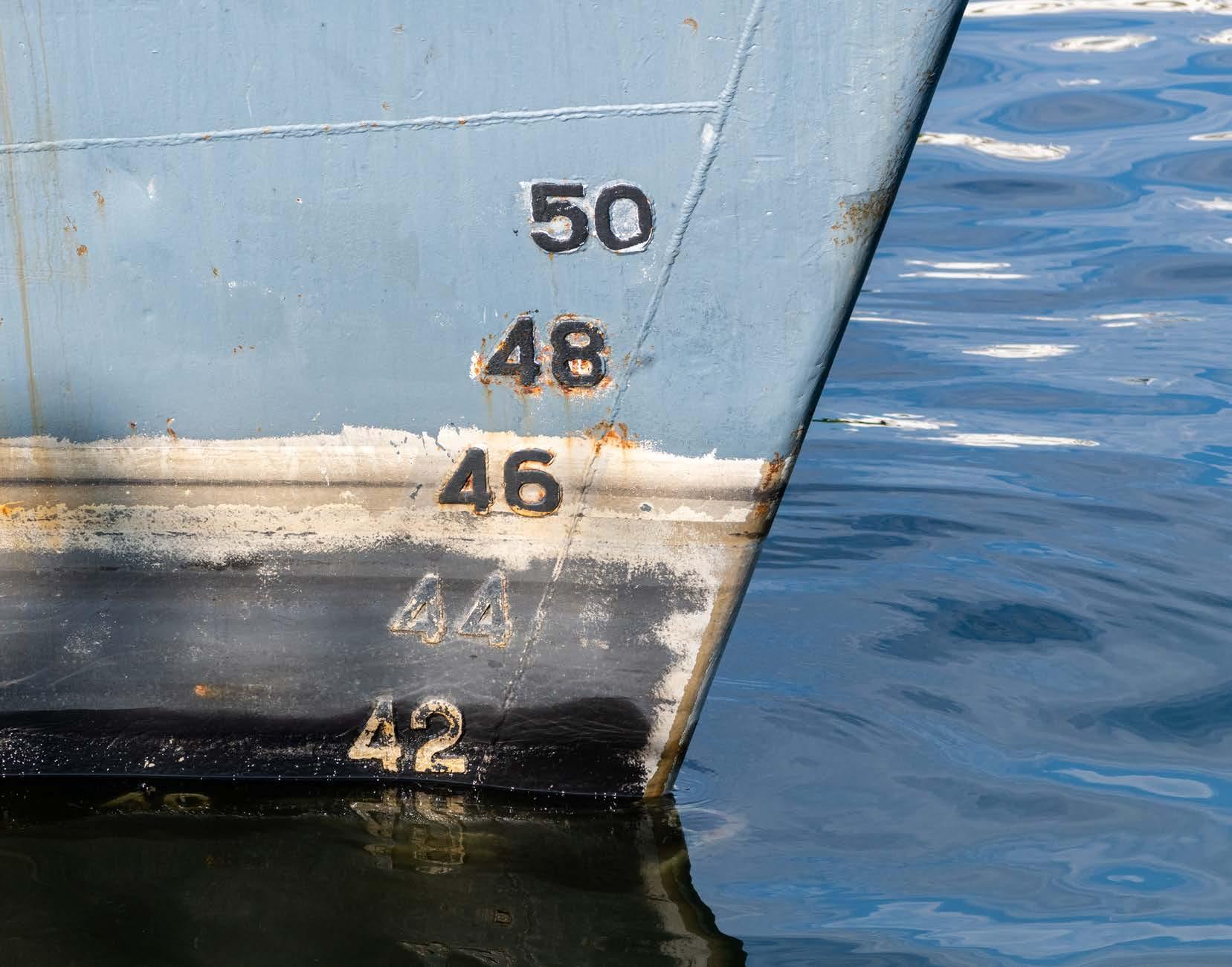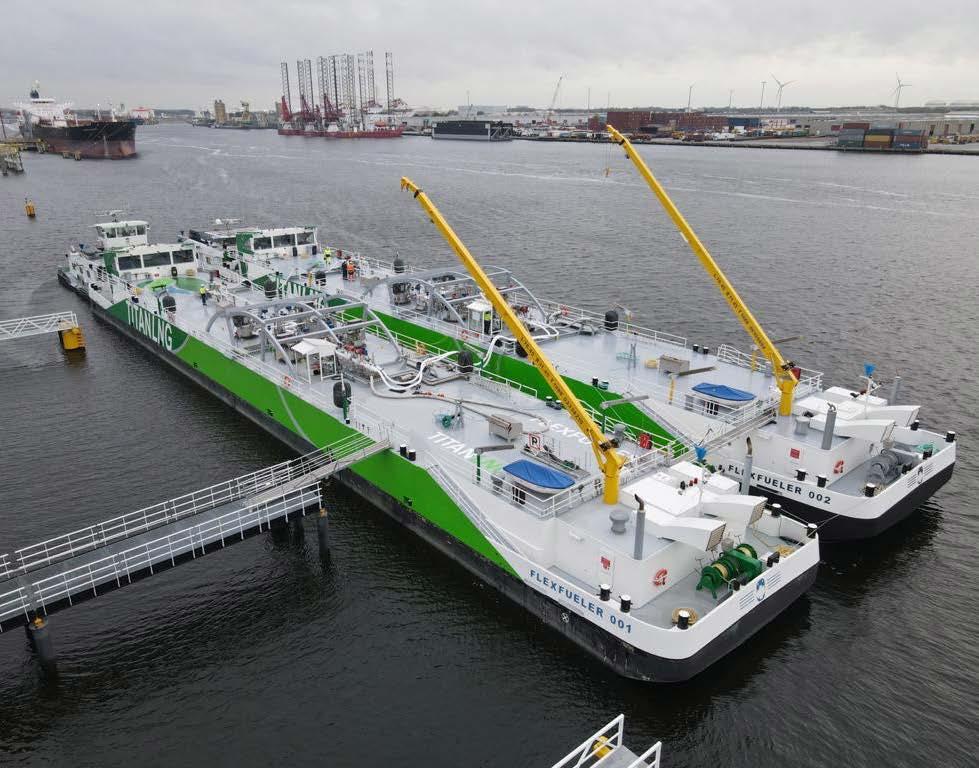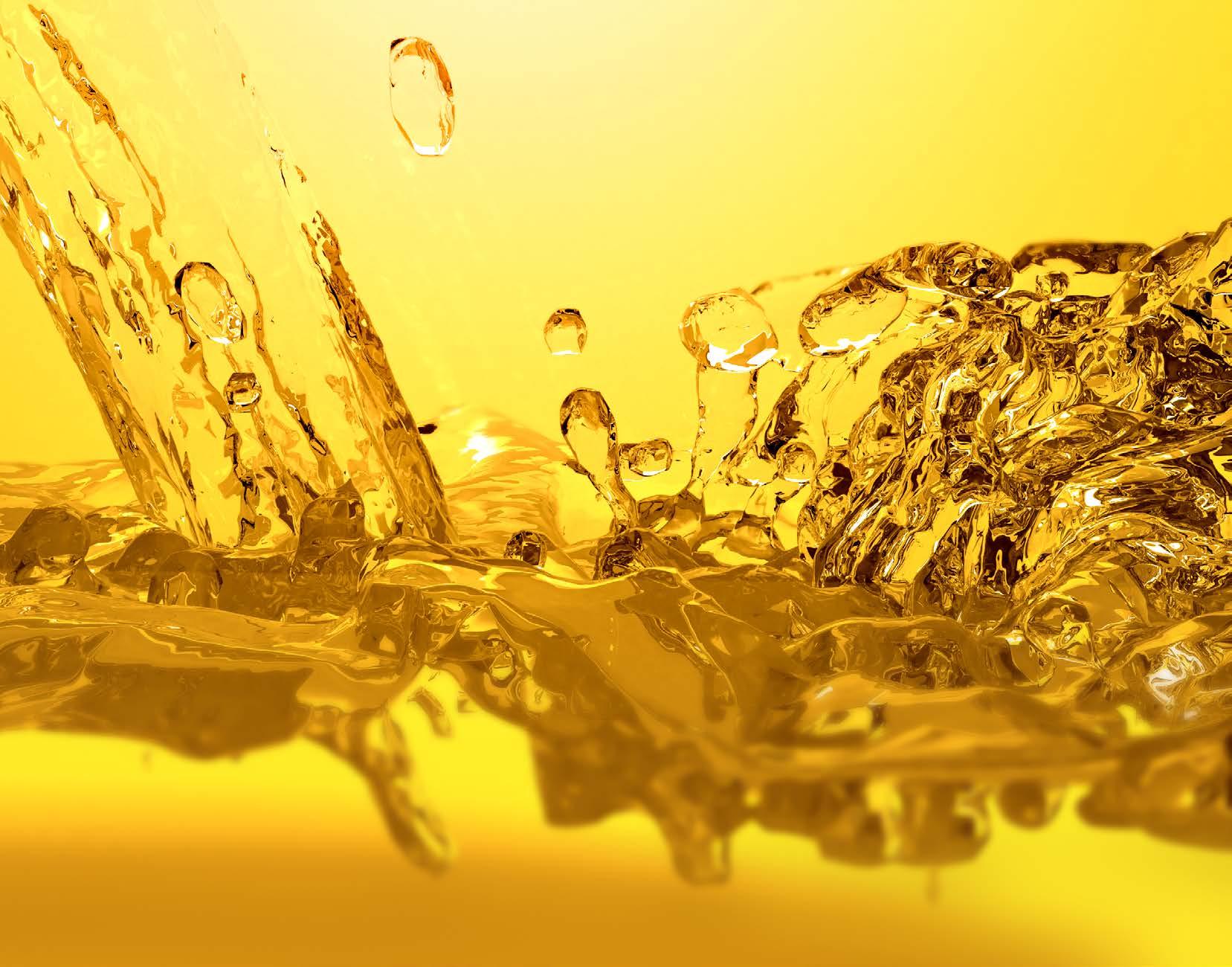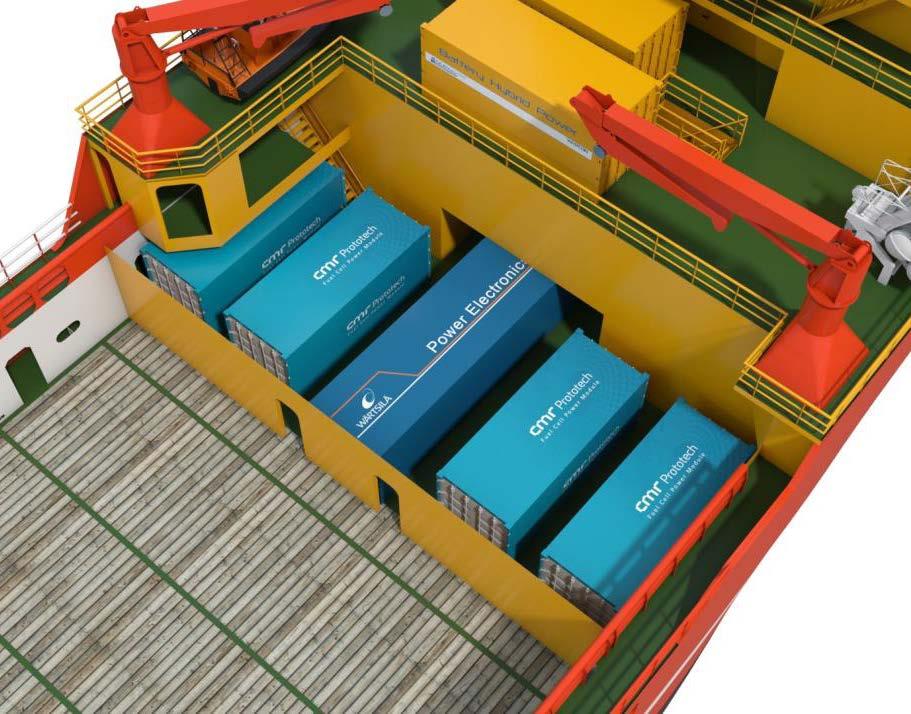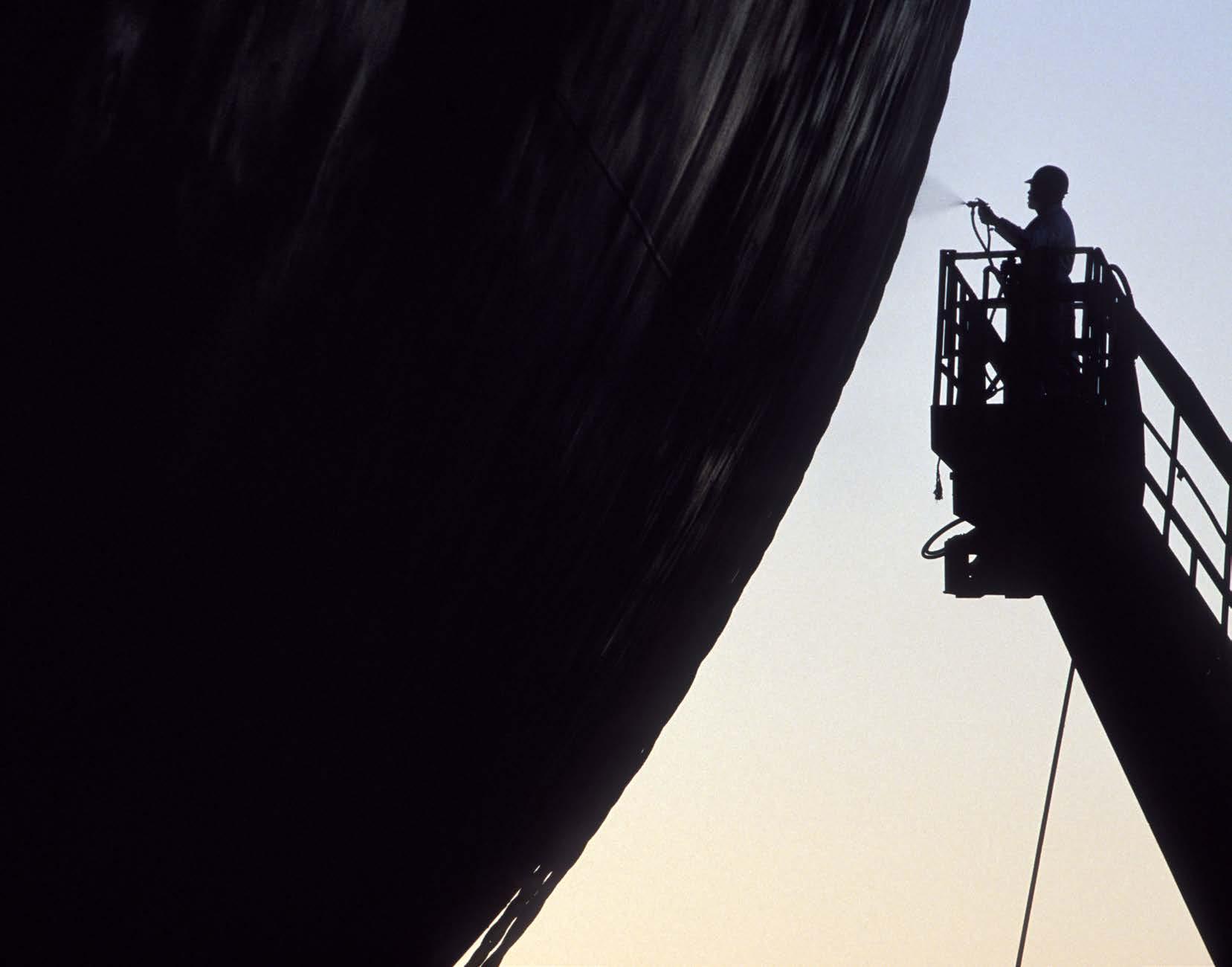
16 minute read
LEADING EDGE
from CSI Spring 2021
by Maritime-AMC
How has the introduction of the International Maritime Organization’s low sulphur cap fared amid what has been one of the most turbulent years in living memory?
IMO2020:
ONE YEAR ON
One year on from the introduction of the International Maritime Organization’s (IMO) low sulphur cap (IMO2020), indications are that the transition has been extremely smooth. This is testament to the preparations of all stakeholders prior to the new rules entering into force, the organisation claims.
“Through 2020, just 55 cases of 0.5% compliant fuel being unavailable had been reported in IMO’s Global Integrated Shipping Information System (GISIS),” says Roel Hoenders, the IMO’s head of air pollution and energy efficiency.”Given that more than 60,000 ships plied the world’s oceans in trade last year, this was a remarkably low percentage of ships encountering difficulty in obtaining compliant fuel.
“We had a great deal of preparation during 2019 and before, from all stakeholders, and all indications are that there have been no significant issues with supply of low sulphur fuel oil.”
Even during the covid-19 pandemic, cargo-carrying ships continued to deliver goods and commodities, including essential foods and medicines, around the world and the introduction and implementation of IMO2020 did not cause any disruptions in trade.
Some ships limited their air pollutants by installing exhaust gas cleaning systems/scrubbers. More than 2,350 systems were formally reported to the IMO as an approved “equivalent method” by flag States administrations.
The majority of ships trading worldwide switched from using heavy fuel oil (HFO) to using very low sulphur fuel oil (VLSFO), which were new blends of fuel oil, produced by refineries to meet the new limit, in accordance with IMO guidance and ISO standards.
Guidance issued by IMO on dealing with the new fuel blends in advance of the new requirement addressed implications of switching to VLSFO, including assessing and managing risks and highlighting potential safety risks, so that the risks can be mitigated.
% of Current Tanker Fleet Fi ed/to be Fi ed with Scrubbers
35%
30% Planning to Retrofit Fi ed
25%
20%
15%
10%
5%
0%
Handy MR LR1/Panamax LR2/Aframax Suezmax VLCC
Through 2020 and into 2021 to date (end January), IMO has not received any reports of safety issues linked to VLSFO.
Nonetheless, during 2020, an IMO correspondence group considered fuel oil safety issues in general and the need for further mandatory requirements to ensure fuel oil supplied meets the required standards and quality.
The group’s report is now available and will be discussed at the next session of IMO’s Maritime Safety Committee (MSC), MSC 103 in May of this year.
Prior to that, the eighth session of the Sub-Committee on Prevention of Pollution from Ships (PPR 8), scheduled to meet remotely from 22-26 March, 2021, will further consider VLSFO fuel quality issues, including possible effects on black carbon emissions.
Provisions in regulation 18 of MARPOL Annex VI regulate fuel oil quality. The International Convention for the Safety of Life at Sea (SOLAS) covers issues such as flashpoint (SOLAS regulation II – 2/4.2.1).
Apart from the requirements in MARPOL Annex VI and SOLAS, VLSFO is required to meet ISO standard 8217, as well as ISO Publicly Available Specification (PAS) 23263, providing guidance as to the application of the existing ISO 8217 marine fuel standard to 0.5% sulphur limit compliant fuel oils.
Following a turbulent 2020 that saw a brief oil price war, a global pandemic and oil demand destruction, it is perhaps not surprising that to many it feels like concerns surrounding IMO2020 have long gone.
Examining the economics of using scrubbers, Gibson Shipbrokers said that prior to the onset of the pandemic, owners of tonnage fitted with scrubbers enjoyed a very healthy discount for high sulphur fuel oil (HSFO) versus VLSFO, which averaged between $250 per tonne and $300 per tonne in key bunkering hubs between December, 2019 and January, 2020.
However, the pandemic-driven oil price collapse meant that the spread sank to just $40–$60 per tonne between April and November last year.
Source: Gibson Shipbrokers
For scrubber fitted tonnage, this meant that the savings for burning HSFO fell from $16,000 per day in January last year to just $3,000-$4,000 per day on the basis of VLCCs trading on TD3C (VLCC – Middle East Gulf/ China) route and slow steaming for most of last year, Gibson calculated.
Despite such a dramatic decline, the scope for scrubber cancellations was limited, due to contractual obligations with shipyards and scrubber manufacturers.
However, more recently, scrubber economics have started to become more favourable once again. Offering some welcome news to those who invested in this technology was the upward trend in oil prices seen in January of this year.
The spread between HSFO and VLSFO widened to around $80–$100 per tonne and scrubber savings climbed to above $5,000 per day for VLCCs.
In terms of tanker statistics, the scrubber uptake is the highest in the VLCC sector, followed by Suezmaxes, Gibson said. However, scrubber use is considerably lower for the smaller size groups.
According to Gibson’s records as at January,2021, scrubbers have been installed on 31% of the existing VLCC fleet, while another 7% is yet to be retrofitted. In addition, 32% of current VLCC orderbook is expected to be fitted with the technology.
As a result, close to 40% of the VLCC fleet could be scrubber-fitted by the end of this year, the shipbroker said.
The actual scrubber penetration in the spot market is expected to be even higher when excluded tonnage (Iranian, sanctioned/storage vessels) are accounted for, while the anticipated recycling during 2021 will also reduce the absolute number of non-scrubber fitted tankers.
Although the scrubber uptake is significant for larger crude carriers, we are unlikely to see further exponential growth, Gibson countered.
Major scrubber manufacturers reported a sizeable slowdown in new scrubber orders last year. Regulatory scrutiny is also expected to intensify. Today, the list of ports where the use of certain scrubber types is banned is extensive, while some governments are calling for a gradual phase out of the technology, for example the EU, or in extreme cases an outright ban – Canada’s stance.
For now, however, while tanker supply/demand conditions remain severely unbalanced, even a modest scrubber premium could mean staying afloat and earnings above daily operating expenses, Gibson said.
Another positive stance was taken by Star Bulk Carriers Corporation’s president, Hamish Norton, during Capital Link’s Dry Bulk Sector webinar in January.
During his talk, he described the company’s scrubber strategy as a good decision. He claimed that the company had already covered half the cost of installing the technology, adding that the company expects to cover the rest of the costs this year.
In 2018, Star Bulk decided to equip its entire fleet with scrubbers, and at the time said that it expected the average cost per unit, including installation, to be below $2m per vessel.
Despite last year’s unfavourable market conditions in terms of bunker prices for shipowners and operators with scrubber-equipped tonnage, Norton said that Star Bulk had hedged fuel spreads at the end of 2019 and at the beginning of 2020.
January’s favourable differential of $100 per tonne will become more advantageous for scrubber-equipped vessels this year.
“We think that the market will get better than that over 2021, as basically jet fuel and other low sulphur transportation fuels increase in demand,” he said during the webinar.
The current bullish sentiment was also shared by Wartsila’s Sigurd Jenssen, who said that scrubber inquiries were picking up again this year.
He also agreed that the fuel price differential would increase going forward making the case for scrubbers more attractive (see Exhaust Gas Cleaning System feature).
Last year, Wärtsilä referred its customers to a report from CE Delft on the climate impact of EGCs.
The study compared the results to the use of low sulphur fuels and was calculated from a well-to-wake perspective in order to achieve an accurate comparison.
It concluded that the environmental impact of EGCS would be less than that of low sulphur marine fuel. The report also noted that CO2 emissions associated with producing and installing an EGCS were small compared to those generated when operating the system.
These emissions were mainly related to the energy demand of the system’s pumps, which typically result in a total increase in CO2 emissions of between 1.5 and 3%.
By contrast, with de-sulphurised fuels, the overall CO2 footprint increase was as a result of the refining processes. Theoretical calculations range from an increase in CO2 emissions of 1% to as much as 25%, when removing the sulphur content of the fuel.
CE Delft said that while the lower figure was not physically possible, the higher percentage increase was applicable only to a quality of fuel that is too high for marine applications.
Therefore, the conclusion was that the CO2 emissions associated with the production of low sulphur fuels would be between these extreme values.
PURETEQ: STATE-OFTHE-ART SCRUBBER SYSTEMS
PureteQ designs, delivers and commissions built-to-fit maritime scrubber systems for open-loop, hybrid-ready and fully hybrid (closed loop, with and without bleed-off) operation to shipowners who want to save money on fuel by continuing to use heavy fuel oil (HFO).
Recently, we have seen the price span between compliant fuel and HFO increase and interest for scrubber systems are increasing with the price span.
All scrubber systems come with state-of-the-art intuitive control systems with full remote accessibility. In times like these, it is very convenient to get 24/7 remote on-line support/ guidance to ship crews from our professional marine engineers. This feature has contributed greatly to all our customers gaining a competitive advantage.
The scrubber system is a design of superior quality, with easily installed water treatment systems. The open tower in-line scrubber system has no moving parts nor obstructions such as a packaging layer. The simple construction also requires less maintenance and is simple to operate for the crew.
For shipowners and operators with remote access, we offer a remote Scrubber System Modular Training Program. In times where crew changes often, “touch and go” remote training has high value for all stakeholders. Some shipowners even choose to have the onshore employees participate in the Remote Specialist Training. In general, training cannot be overestimated as it leads to higher up-time and compliance rates as well as better performance and less operational costs.
SERVICE PROVIDER
PureServ is PureteQ’s dedicated service organisation. We offer fairpriced service agreements designed to meet shipowners’ specific needs based on a ship’s operational pattern and qualification of its crew.
All clients with a PureteQ service agreement have a designated service engineer – according to the agreement, you only pay for what you get.
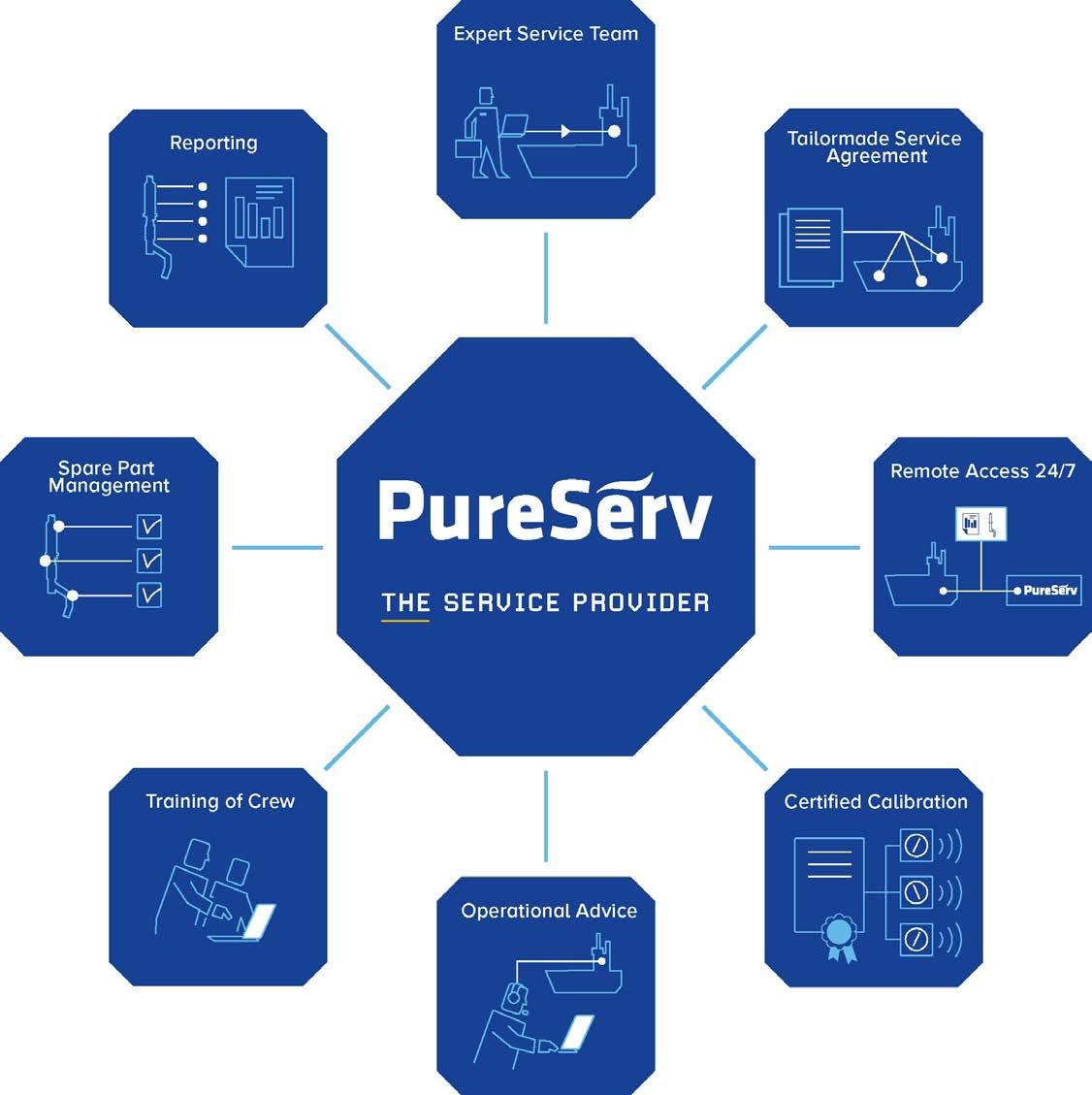
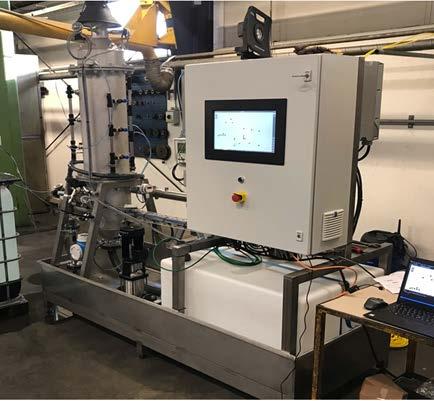
Test setup (micro scrubber)
Our service team has received extensive training to assist shipowners in safeguarding continuous operation, reliability and MARPOL compliance of their scrubber systems. This entails expert support and guidance for all scrubber systems on-site or via the safe PureteQ remote system, depending on the ship’s conditions and the client’s requirements. Our validated concepts allow us to assist crews remotely with trouble shooting and advice on operation and maintenance, as well as optimisation and training of new crew.
PureteQ PureServ is happy to quote a service agreement for scrubber systems of any brand to safeguard MARPOL compliance as well as optimise operational performance.
GENERATION II SCRUBBER
PureteQ Scrubber Systems are among the most reliable, safe and user-friendly scrubber systems in the industry. On top of that, PureteQ scrubbers feature the lowest OPEX in the business, as well as being easy to install. We have now simplified the installation even further in our “Generation II” scrubber system.
This scrubber system aims to reduce the total cost of installation, considering the experience of installing more than 100 scrubbers on different types of ships at various shipyards around the world.
From 2018-2020, the total cost of installation almost tripled on most shipyards across the world. We as manufacturers took on the responsibility to make green investments more attractive to shipowners and therefore set an ambitious goal to decrease the total cost of installation by 40% on retrofit projects and 25% on newbuildings.
We have not reached this ambitious goal just yet, but we have, nevertheless, produced ideas that will significantly cut the cost of installing PureteQ scrubbers, by double digit percentages. CO2 CAPTURE AND REUTILISATION
In 2020, we began a research programme into carbon capture and reutilization technology and have now applied for patent on a process that combines carbon capture from exhaust gas with Power to X. Combining the processes allows for lower cost of removing/reducing CO2 as some of these costs are offset by earnings/ benefit of producing hydrogen.
Currently, we are performing tests on lab scale and we have fully automised the system (PureteQ control system), so that the cell and micro scrubber is working 24/7. The results are promising. Our test on the scrubber tower is progressing and we have now begun testing the tower in an industry located just 30 miles from our HQ. We are testing on relatively clean gas from LNG-fuelled generator sets, so there is no fluid treatment/cleaning involved yet. We are now building a bigger scale plant with a small PureteQ scrubber on a portable skid, so that we can transport it to different locations, testing various types of exhaust gasses.
Furthermore, PureteQ is involved in a project based on an American patent of chemical sequestering of CO2. The process transforms the CO2 to sodium carbonate and sodium bicarbonate (baking soda), which in turn can be used to augment oceans’ natural carbon cycle or other purposes.
Finally, we are involved in a Dutch CO2 capture project together with DTU. The aim is to reduce the current cost of carbon capture in amine processes.
We are always happy to elaborate on our CO2 project, Generation II scrubber, service concepts and extensive knowledge of maritime scrubbers in general for all interested parties.
For more information, contact: Anders Skibdal, CEO Tel: + 45 4017 1400 Email: anders@pureteq.com
Michael Mouritzen, Sales Director Tel: +41 4014 4481 Email: mim@pureteq.com
ECOSPRAY: A CLEAR VISION FOR A CLEANER FUTURE
The past year has redefined the rules, causing us to face a turnaround in our perspectives. The maritime industry is not only dealing with a crisis due to the pandemic, but is growing and adapting to new challenges and preparing for the future: 2050.
Since industry urgencies have changed, we need to consider the long-term perspective. Not just when it comes to regulations, but also environmental awareness and sustainability. Together with the latest technologies, these are the drivers towards the CO2-neutral path. Decarbonization is undoubtably the most important priority in our industry and a crucial opportunity – even if, in terms of applicability, the regulatory framework still requires clarity.
The Ecospray path towards decarbonization functions with a new business model, new products and remarkable technology in order to achieve the 2050 zero emission target. With a clear vision in mind – to make clean energy a reality – Ecospray has, in the past year, invested time and effort into developing new solutions and finding innovative ways to approach the market.
“We saw 2020 as entering a big tunnel, but we wanted to invest as much as we could to prepare for the end of the tunnel in order to serve the market in the best possible way,” says Ecospray CEO Stefano Di Santo. “Ecospray’s technological solutions leverage three distinctive factors: technology delivered as a service; the analysis and use of relevant data; and finance, to facilitate access to innovation and significantly advance the transition towards decarbonization and the creation of clean energy.”
Ecospray’s mission to tackle the environmental impact of all industries is solidified by a new business model: not limiting itself solely to being a scrubbermaker, but becoming a multi-product company and empowering digitalisation ranging from technology to process, and products to services. This visionary approach, in collaboration with Relayr – a company specialising in internet of things (IoT) solutions – ultimately envisions the adoption of a model based on a pay-peruse offering, through which equipment is no longer purchased, but provided in exchange for a usage fee.
Offering innovative financing options, we will be able to create even more value for our customers and ensure that they can focus on their core business.
OUR ROADMAP TO 2050
Concurrently, we have never ceased doing what we were created to do: uncovering new innovative solutions, skipping one generation of technological evolution and meeting with new challenges across brand new sectors.
For more than a year, we have been working on a solution for decarbonization, in collaboration with universities and research centres. Our fuel cell technology is unique, as it reduces costs and environmental impact, coupling carbon capture with energy production simultaneously. With a cross-industry application, the Carbon Friendly Fuel Cells feature a different technology than that typically used, which we believe will be in use by 2023.
If our horizon is 2050, our newest solutions – ranging from emissionremoval AI systems to fuel-saving and air-and-water filtration solutions – represent the present. Smart scrubbers and new technologies to sanitize onboard spaces are just two examples.
An advanced remote AI-enabled control and monitoring system is the technical core of our new smart scrubber: the integration of Relayr’s IoT and AI allows us to guarantee constant compliance with International Maritime Organization regulations for the containment of air pollution in the maritime environment. Moreover, it allows significant savings in terms of performance and maintenance through remote monitoring and advanced lifecycle analysis. The ability to constantly monitor and analyse the scrubbers’ performance ensures longer equipment life and fuel savings by optimising pumping operation, while also allowing for a significant reduction in operating costs.
Regarding health and safety, the need to sanitize onboard environments and surfaces from viruses and bacteria has galvanised us to deliver our latest solutions for air treatment. BreathES drastically reduces pathogens and contaminants inside closed spaces, in the air and on surfaces, ensuring a smoother “return to service” for passenger and other ships and providing a safe environment for guests and crews.
BreathES is a package that combines different technologies (including UVGI lights, bi-polar cold plasma ionizers and filtration) with an air-quality monitoring system and a centralised control unit with shoreside/cloud data collection and analysis. Everything is connected in our signature platform One: from real-time awareness to performance, analytics, and maintenance services, the EGCS are under control.
Substantial research and development investments have also brought about the development of several water treatments. With our innovative solutions for vessels, available from the second half of 2021, performances beyond compliance will be achieved on a variety of applications, including DeSOx wash water, galley and laundry water, and bilge water.
We have a clear vision for the future, as outlined by our roadmap to 2050: decarbonization is now inevitable and imperative, so we have made a choice for our future. We truly believe that all our technologies for the planet actively support decarbonization and the creation of green power.
For more information, contact: Ecospray Technologies Via Circonvallazione 14/14A 15050 Alzano Scrivia (AL) Italy Email: info@ecospray.eu Tel: +39 0131854611 ecospray.eu


